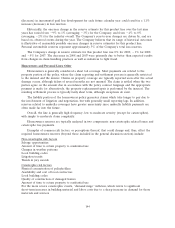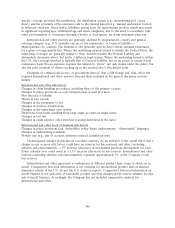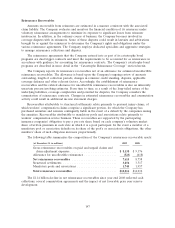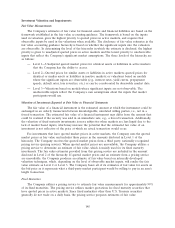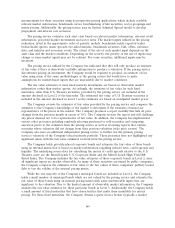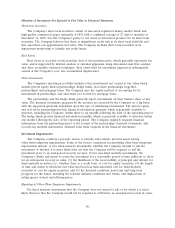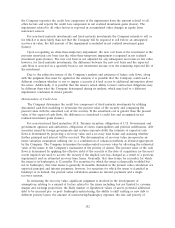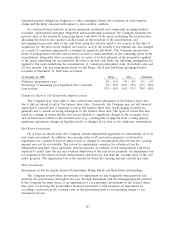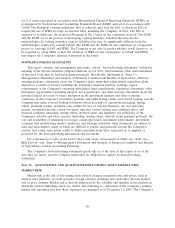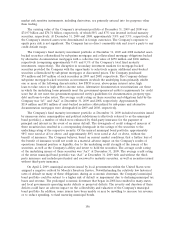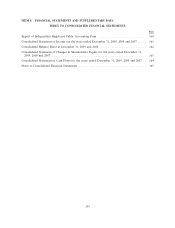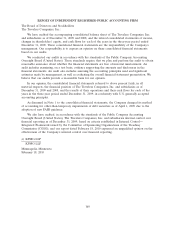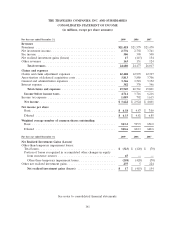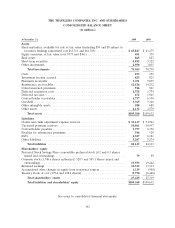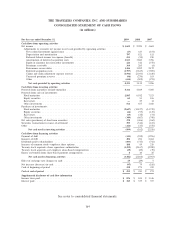Travelers 2009 Annual Report Download - page 166
Download and view the complete annual report
Please find page 166 of the 2009 Travelers annual report below. You can navigate through the pages in the report by either clicking on the pages listed below, or by using the keyword search tool below to find specific information within the annual report.Mortgage Loans
A mortgage loan is considered impaired when it is probable that the Company will be unable to
collect principal and interest amounts due. For mortgage loans that are determined to be impaired, a
reserve is established for the difference between the amortized cost and the fair market value of the
underlying collateral. In estimating fair value, the Company uses interest rates reflecting the current
real estate financing market returns. The Company did not have any impaired mortgage loans at
December 31, 2009 and 2008.
Goodwill and Other Intangible Assets Impairments
The Company performs a review, on at least an annual basis, of goodwill held by the reporting
units which are the Company’s three operating and reportable segments: Business Insurance, Financial,
Professional & International Insurance, and Personal Insurance. The Company estimates the fair value
of its reporting units and compares it to their carrying value, including goodwill. If the carrying values
of the reporting units exceed their fair value, the amount of the impairment is calculated and goodwill
is adjusted accordingly.
In the fourth quarter of 2008, the Company changed its methodology for estimating the fair value
of its reporting units from a multiple of earnings model to a discounted cash flow model. This change
was made as a result of the effects of a severe disruption of the credit and equity markets and
significant changes in the insurance industry that caused disparities between the multiple of earnings of
the Company and the observed multiple of earnings of its competitors. The discounted cash flow model
is an income approach to valuation that is based on a more detailed analysis for deriving a current fair
value of reporting units and is more representative of the Company’s reporting units’ current and
expected future financial performance. The change in methodology resulted in a change in estimate of
the fair value of the reporting units for purposes of testing goodwill for impairment. Other indefinite-
lived intangible assets held by the Company are also reviewed for impairment on at least an annual
basis. The classification of the asset as indefinite-lived is reassessed, and an impairment is recognized if
the carrying amount of the asset exceeds its fair value.
Intangible assets that are deemed to have a finite useful life are amortized over their useful lives.
The carrying amount of intangible assets with a finite useful life is regularly reviewed for indicators of
impairment in value. Impairment is recognized only if the carrying amount of the intangible asset is not
recoverable from its undiscounted cash flows and is measured as the difference between the carrying
amount and the fair value of the asset.
The Company’s review did not result in an impairment of its indefinite-lived or finite-lived
intangible assets for the years ended December 31, 2009, 2008 and 2007.
OTHER UNCERTAINTIES
For a discussion of other risks and uncertainties that could impact the Company’s results of
operations or financial position, see note 15 of notes to the Company’s consolidated financial
statements and ‘‘Item 1A—Risk Factors.’’
FUTURE APPLICATION OF ACCOUNTING STANDARDS
See note 1 of notes to the Company’s consolidated financial statements for a discussion of recently
issued accounting standards updates.
The Company is currently required to prepare its financial statements in accordance with U.S.
Generally Accepted Accounting Principles (GAAP), as promulgated by the Financial Accounting
Standards Board (FASB). During 2008, the Securities and Exchange Commission (SEC) issued a
proposed Roadmap for comment for the potential use in filings with the SEC of financial statements
154


